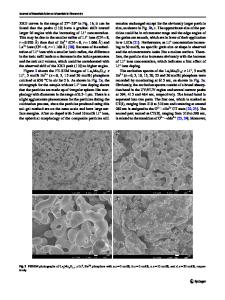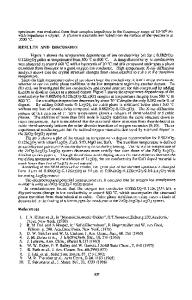Luminescence enhancement of Eu 3+ -activated La 2 Mo 2 O 9 red-emitting phosphor through chemical substitution
- PDF / 294,198 Bytes
- 5 Pages / 584.957 x 782.986 pts Page_size
- 111 Downloads / 278 Views
A series of red-emitting phosphors with compositions of La2(Mo1 zSiz)2O9:0.05Eu31 (0 # z # 0.10) with strong near-UV absorption were prepared by solid-state method. The structure and luminescence properties were investigated by x-ray powder diffraction, UV–vis diffuse reflectivity, and photoluminescence spectra. The luminescent properties as a function of Si41 concentrations were systematically studied. Under excitation of a wide range near-UV (250–430 nm) or blue light, Si41-doped series phosphors exhibit characteristic red emission of Eu31 peaked at 615 nm. The incorporation of Si41 into La2Mo2O9:0.05Eu31 phosphor leads to the improvement of the excitation broad band and sharp peaks, as well as the broadening of charge transfer band. Appropriate amount of Si41 doping can enhance the red luminescence intensity. Finally, the possible reasons for the luminescence enhancement via the corporation of Si41 were explained.
As a high energy efficiency, ecofriendly, long-lifetime, and compact alternative to traditional lighting sources, solid-state lighting (SSL) in form of white light-emitting diodes (white LEDs) has received considerable attention. Nowadays, the phosphor-converted white LEDs (pc-white-LEDs) fabricated using a blue GaN chip or near-UV LED (370–420 nm) coupled with red, green, and blue phosphors are becoming the most attractive SSL devices because of its continuing improvement in the efficiency.1–5 The eventual performance of pc-white-LEDs devices strongly depends on the luminescence properties of the phosphors used. Therefore, the state-of-the-art SSL devices would be notably advanced by the discovery of phosphor materials that are optimized for pc-white-LEDs. The most frequently used red-emitting phosphor for nearUV LEDs is Y2O2S:Eu31. However, Y2O2S:Eu31 has poor absorption in near-UV region where LED chips emission occurs. A good strategy to overcome this problem is to search for a host lattice that can absorb energy efficiently in the near-UV region and transfer the energy to the activator, resulting in emission in the red region (host-sensitized emission).6,7 In view of practical applications, improvement of luminescence of phosphors is of great importance, especially for pc-white-LEDs while retaining the high quantum yield and high luminescence quenching temperature. Currently, modification of phosphor composition by chemical substitution is a highly effective strategy for the
a)
Address all correspondence to this author. e-mail address: [email protected] DOI: 10.1557/jmr.2011.269 J. Mater. Res., Vol. 26, No. 18, Sep 28, 2011
http://journals.cambridge.org
Downloaded: 29 Mar 2015
designing of new materials and improving luminescent properties of already known compounds.8–12 Lanthanum molybdate (La2Mo2O9) has ever been studied as catalyst, fast oxide-ion conductor, and ferroelectric material.13–15 Marrero-López et al. reported for the first time the photoluminescence properties of Eu31-doped La2Mo2O9 phosphor.16 Recently, the development of SSL has lead to a rebirth of interest in this material because
Data Loading...











